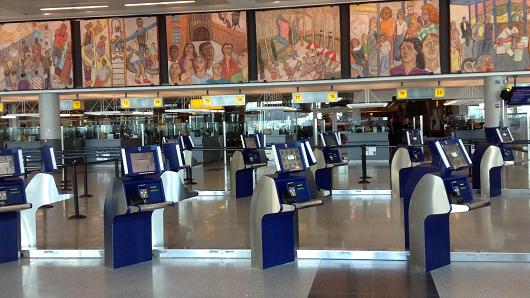
September 18, 2014
What Ever Happened to Experience Design?
Technology isn’t a substitute for human-centered solutions.

New passport kiosks at JFK international airport
Courtesy Delta Airlines
On a Saturday evening in mid-July, after an especially bumpy flight over the Atlantic, we land at New York’s JFK international terminal. As we proceed to immigration, I can feel the warm glow of the Tuscan sun fading from my memory. Already a stressful experience—what with several transoceanic carriers disgorging masses of exhausted, cranky travelers into what becomes a tight funnel—something new has been added this evening: automated kiosks.
Lined up in several rows, neat computer screens glow at the far end of the dusky hall, signaling what we’re about to experience. Maybe there are signs that explain what’s coming, but I don’t see any. The few people who herd us are equally opaque with their instructions. As we get closer to the waiting screens, a man urges a group of us to step forward and interact. Facing the familiar consoles, I find an easy-to-decipher graphic interface that quickly takes me through a short questionnaire. The process ends when my photo is snapped and the computer prints a slip of paper.
No one tells us what we do with the pieces of paper that bear our frazzled portraits. Some of us form another line while others mill around the computers waiting to get their instructions. Our line, now a mean and tense crowd with veins popping from brows, shuffles toward the agents who have that distinct deer-in-the-headlights look about them.
Clearly, this is not what all the hype about automated immigration kiosks promised us: a quick, comfortable, seamless, pleasant homecoming. What went wrong? What we got is a great digital system for keeping track of the traveling public. What we did not get is a recognition that the immigration process is much more complex than a brief interaction with a smart machine.
It is a many-layered service to the people by our government. We, the people, need to be put at the center of it all. We need the help of experience designers focused on human interaction, aided by instructive words rendered in clear graphics. The whole system needs to be designed.
The machines that process passports in a matter of seconds need to be backed up by kind people who tell us where to go, what to do when we get there, help us click through the form and calm us if we’re spooked by it, then show us the next step. The role of friendly, cheerful helpers would have gone a long way in welcoming us home.
As I drag my roll-aboard through the final checkpoint, the tense immigration officer (perhaps imagining the unemployment line) takes my newly printed immigration form, not the customs declaration. He took that document from the person who went before me—why did he forget mine?
This uneasy reentry makes me think that, for decades now, we have bought into tech fixes that initially drive us crazy. Human-centered experience design can remedy this condition of anxiety and inefficiency. What are we waiting for?
Recent Viewpoints
Viewpoints
Navigating the Path to Net Zero





